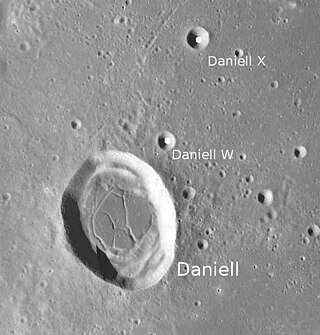
Daniell is a lunar impact crater located in the southern half of the Lacus Somniorum. To the south-southeast is the much larger crater Posidonius. The Rimae Daniell rille system are to the west of Daniell crater.

Artamonov is a lunar impact crater on the far side of the Moon. Its eroded outer rim does not have the circular shape of most lunar craters, but the overall shape of three or four merged craters. The largest is in the south, with smaller circular bulges to the north and east.

Baily is the remnant of a lunar impact crater on the boundary between Mare Frigoris to the north and Lacus Mortis to the south. The crater interior has been flooded by lava in the past, and only the northern half of the crater rim remains relatively intact. There is an outward bulge in the northeastern rim, possibly the remnant of another crater formation that once overlapped Baily. The crater interior is flat and relatively featureless, with no impacts of significance. The surviving outer rim reaches a maximum elevation of about 0.5 km.

Bilharz is a lunar impact crater that lies in the eastern part of the Mare Fecunditatis. It is the largest member of a close triple-crater formation with Atwood to the east and Naonobu to the northeast. To the southeast is the crater Langrenus.

Nishina is the remnant of a lunar impact crater that is located in the southern hemisphere on the far side of the Moon. It lies to the south-southwest of the crater Maksutov, to the southeast of Finsen and Leibniz.

Keldysh is a lunar impact crater that is located in the northeastern part of the Moon, at the eastern rim of the Mare Frigoris. It lies due north of the prominent crater Atlas, and to the northeast of the notable Hercules.
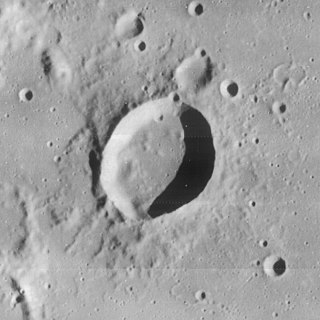
Clausius is a lunar impact crater that is located in the southwest part of the Moon, in the small lunar mare designated Lacus Excellentiae. It is completely enclosed by mare material, although the tiny satellite crater Clausius A lies just to the north. The rim of Clausius is low and sharp, with a slightly oval shape that is longer in the north–south direction. The interior floor has been flooded by basaltic lava, and appears level and featureless with a darker surface that matches the mare surface that surrounds the crater exterior.

Esclangon is a lunar impact crater that is located in the rugged terrain to the northwest of the prominent crater Macrobius, and east of Sinus Amoris. Its diameter is 15 km. It was named after French astronomer Ernest Esclangon. This formation was previously designated Macrobius L. Just to the west-southwest is the crater Hill. Lacus Bonitatis, the Lake of Good, is located to the east and northeast of Esclangon.

Dechen is a small, bowl-shaped crater that is located in the northwest part of the Oceanus Procellarum, near the northwest limb of the Moon. The rim of the crater projects slightly above the surrounding lunar mare, and the interior is symmetrical and nearly featureless. It lies to the northeast of the crater Harding, but is otherwise relatively isolated.

Daubrée is a lunar impact crater that is located to the southwest of the Mare Serenitatis, just to the west-southwest of the crater Menelaus in the Montes Haemus range. The small lunar mare Lacus Hiemalis lies along the southwest rim of Daubrée. The crater was named after French geologist Gabriel A. Daubrée. It was previously designated Menelaus S.

Lallemand is a small lunar impact crater that lies near the western limb of the Moon, in a region where the visibility is affected by libration effects. Because of its location, when viewed from the Earth the crater is viewed nearly from the side, limiting the amount of detail that can be seen. It lies in the northeast part of a mountain range named the Montes Rook that forms a ring around the enormous Mare Orientale impact basin. To the northeast is the Lacus Autumni and to the northwest lies the Lacus Veris, both forming small lunar maria along the sides of the range.

Hecataeus is a large lunar impact crater that lies near the eastern limb of the Moon. It is attached to the northern rim of the walled plain Humboldt. To the northeast is the smaller crater Gibbs. East of Hecataeus is a chain of small craters forming a line radial to Humboldt; these are designated the Catena Humboldt, named after the walled plain.

Davisson is a lunar impact crater that is located on the far side of the Moon from the Earth. This crater lies across the eastern rim of the huge walled plain Leibnitz, and the rim and outer rampart intrudes into the interior floor of Leibnitz. To the east-northeast of Davisson is the walled plain Oppenheimer, a formation only somewhat smaller than Leibnitz.

Chevallier is a lunar impact crater that is located in the northeastern part of the Moon's near side, about a crater diameter east-southeast of the prominent crater Atlas. To the south-southeast of Chevallier is the flooded crater Shuckburgh. Chevallier was named by the IAU in 1935.

Plana is a lunar impact crater that lies on the boundary between two small lunar mare areas, with Lacus Mortis to the north and the larger Lacus Somniorum on the southern side. It was named after Italian astronomer Giovanni Antonio Amedeo Plana. It is joined to the crater Mason to the east by a short stretch of rugged ground. Due north of Plana in the midst of the Lacus Mortis is the prominent crater Bürg.

Drebbel is a small lunar impact crater named after Cornelius Drebbel that is located to the northeast of the large walled plain Schickard, in the southwestern part of the Moon. Further to the northeast is the Lacus Excellentiae and the small crater Clausius.
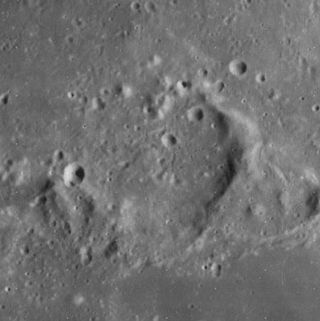
Williams is the remnant of a lunar impact crater that lies to the south of the prominent crater Hercules, in the northeastern part of the Moon. The southern rim borders the Lacus Somniorum, a small lunar mare that extends to the south and west. To the southwest is the sharp-rimmed crater Grove.
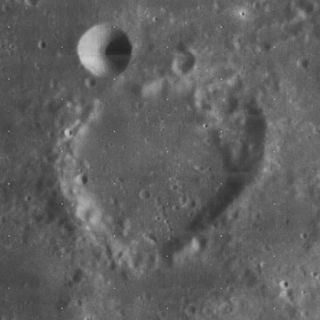
Shuckburgh is a lunar impact crater that is located in the northeastern part of the Moon's near side, named after Sir George Augustus William Shuckburgh-Evelyn. It lies south-southeast of the flooded crater Chevallier and northwest of Hooke, roughly midway between these two formations. To the northeast is the Lacus Temporis plain.

Volkov is a lunar impact crater on the Moon's far side. It is located to the north of the prominent crater Tsiolkovskiy, and east-southeast of Dobrovol'skiy. Overlying the southeastern rim of Volkov is the satellite crater Volkov J, and the two have merged to form a figure-8 shape. The crater Lander is attached to the southwest rim of Volkov J, making this a triple-crater formation.
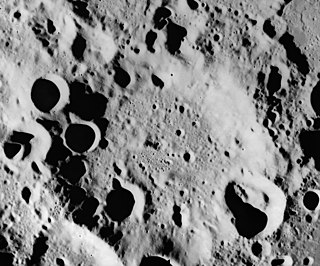
Titius is a lunar impact crater that is located on the Moon's far side, beyond the eastern limb. It lies to the west of the Lacus Solitudinis, a small lunar mare. Less than a crater diameter to the north east is the crater Bowditch, and farther to the southwest is Donner.





















